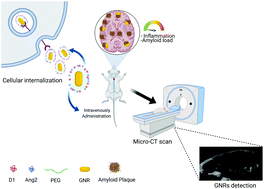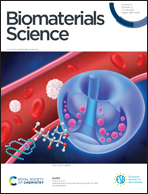In vivo micro computed tomography detection and decrease in amyloid load by using multifunctionalized gold nanorods: a neurotheranostic platform for Alzheimer's disease†
Abstract
The development and use of nanosystems is an emerging strategy for the diagnosis and treatment of a broad number of diseases, such as Alzheimer's disease (AD). Here, we developed a neurotheranostic nanosystem based on gold nanorods (GNRs) that works as a therapeutic peptide delivery system and can be detected in vivo for microcomputed tomography (micro-CT), being a diagnostic tool. GNRs functionalized with the peptides Ang2 (a shuttle to the Central Nervous System) and D1 (that binds to the Aβ peptide, also inhibiting its aggregation) allowed detecting differences in vivo between wild type and AD mice (APPswe/PSEN1dE9) 15 minutes after a single dose by micro-CT. Moreover, after a recurrent treatment for one month with GNRs-D1/Ang2, we observed a diminution of amyloid load and inflammatory markers in the brain. Thus, this new designed nanosystem exhibits promising properties for neurotheranostics of AD.

- This article is part of the themed collection: Celebrating Latin American Chemistry


 Please wait while we load your content...
Please wait while we load your content...